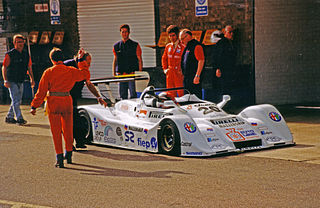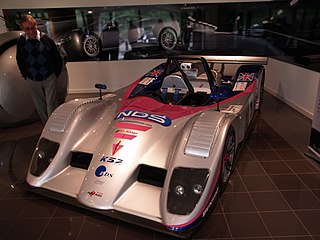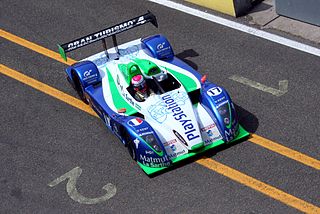
The European Le Mans Series (ELMS) is a European sports car racing endurance series inspired by the 24 Hours of Le Mans race and run by the Automobile Club de l'Ouest (ACO). The European Le Mans Series is similar to the American Le Mans Series (ALMS) based in the United States and Canada that was running with ACO and IMSA between 1999 and 2013. ELMS team champions and runners-up receive an automatic entry to the following year's 24 Hours of Le Mans. Originally titled the Le Mans Endurance Series before becoming simply the Le Mans Series in 2006, the series was renamed once more in 2012, reusing a name previously utilized by IMSA in 2001.
Radical Sportscars is a British manufacturer and constructor of racing cars. The company was founded in January 1997 by amateur drivers and engineers Mick Hyde and Phil Abbott, who built open cockpit sportscars which could be registered for road use and run on a track without modification. Radical produce a mix of purpose built race cars as well as road legal sports cars in varying specifications. The most popular racecar produced to date is the radical SR3 with the V6 RXC being their most numerous road legal sportcar.
The Peugeot 905 is a Sports-prototype racing car introduced for Sportscar racing.

Warren Hughes is a racing driver from Newcastle, England. He has raced in a variety of different series, most notably the British Touring Car Championship (BTCC), the FIA GT1 World Championship, the Le Mans Series, the FIA World Endurance Championship and the 24 Hours of Le Mans. He won the LMP2 category of the 24 Hours of Le Mans in 2005, driving for RML Group alongside Tommy Erdos and Mike Newton.
The Lola T92/10 was a Group C sports car developed by Lola Cars as a customer chassis for the 1992 World Sportscar Championship season. It would be the final sports car built by Lola until their return in 1998.
Debora Racing cars is a small French car builder, popular with private racing teams, based in Besançon, France. Teams generally use their chassis to take part in Le Mans style endurance racing such as Magny Cours, Jarama and le Mans.
Gary Chalandon is a French racing driver. He is most notable for competing in the 24 Hours of Le Mans, Formula Le Mans Cup and the Le Mans Series. He won the Formula Le Mans class of the Le Mans Series in 2010, whilst driving for DAMS.

The Debora LMP296 was a Le Mans Prototype, built by Debora Automobiles in 1996 for use in the 24 Hours of Le Mans. The car was originally entered with a 2-litre turbocharged Cosworth straight-four engine, but several other engines were used in the car's three-year career. Two cars are known to have been built. In conjunction with the LMP297, the car helped Waterair Sport to the International Sports Racing Series SR2 Team's Championship in 1998. The LMP296 was updated into the LMP299 for 2000.
Centenari Racing SRL, usually referred to as Centenari, was an Italian racing team and chassis constructor company based in Italy, predominantly building sports prototypes. The team were active in international events between 1997 and 2006, having started off in national events in 1991.
Greaves Motorsport is a British racing team, currently competing in the European Le Mans Series and the 24 Hours of Le Mans.

The Centenari M1 was a Le Mans Prototype, originally built by Centenari in 1991 for the Italian Prototype Championship. In 1997 and 1998, it was used in the SR2 and the CN category of the International Sports Racing Series. Two cars are known to have been built.
The Centenari Mac3 was a Le Mans Prototype, originally built by Centenari in 1998 for the CN category of the International Sports Racing Series. It was updated in 2006, and the new version was renamed as the MG3. Both cars used the same naturally-aspirated 3.0 L Alfa Romeo V6 engine. The Mac3, in conjunction with the older M1 model, helped Centenari to take joint-second in the 1998 International Sports Racing Series CN Team's Championship.
The Debora LMP200 was a Le Mans Prototype, built by Debora in 2001 for use in the European Le Mans Series. Initially fitted with a 3.2-litre BMW straight-six engine, it was refitted with a 3-litre BMW straight-six in 2002, and then a 3.4-litre Mader-BMW straight-six in 2003. One car is known to have been built. The LMP200 was used by Didier Bonnet Racing when they won the European Le Mans Series in 2001.
The Debora LMP2000 was a Le Mans Prototype, built by Debora in 2000 for use in the 24 Hours of Le Mans and the Sports Racing World Cup. The car was initially fitted with a 3.2-litre BMW straight-six engine, but had a 3-litre BMW straight-six fitted for the Sports Racing World Cup. One chassis is known to have been built.

The Ascari A410 was a Le Mans Prototype built by Ascari Cars in 2000. The car, which was based on the Lola T92/10 Group C racing car, featured a 4-litre Judd GV4 V10 engine, and was used in European and international sports car racing events. In 2002, it was renamed as the Ascari KZR-1 and shipped to the United States for usage in the American Le Mans Series. Two cars were built.

The Lavaggi LS1 was a Le Mans Prototype (LMP) built by Scuderia Lavaggi. Built in 2005, the LS1, initially using a 6-litre Ford V8 engine, made its racing debut the following year. However, the car proved unreliable, and Lavaggi replaced the Ford engine with a 4-litre AER P32C twin-turbocharged V8 for the 2008 season, with no notable improvement in reliability or performance. The car was retired at the end of the 2009 season.
The Rapier 6 was a sports prototype racing car built by LM3000 in 1999. It used a 3-litre Nissan V6 engine, and Team Sovereign ran the car in the FIA Sportscar Championship. The car achieved moderate success, and Team Sovereign retired it at the end of the 2003 season, after the series folded. In 2011, it reappeared in the Britcar series, being driven by Mike Millard.

The Courage C60 was a Le Mans Prototype (LMP) racing car built by Courage Compétition in 2000, and used in international sports car races until 2006. A replacement for the Courage C52, it was Courage's first all-new prototype since the Courage C41 was built in 1994.
The 2016 FIA World Endurance Championship season was the fifth edition of the FIA World Endurance Championship auto racing series co-organised by the Fédération Internationale de l'Automobile (FIA) and the Automobile Club de l'Ouest (ACO). The series was open to Le Mans Prototypes and grand tourer-style racing cars meeting four ACO categories. The season began at the Silverstone Circuit in April and ended at the Bahrain International Circuit in November, and included the 84th running of the 24 Hours of Le Mans. This season was also the last WEC season for Audi Sport Team Joest as they decided not to race in the 2017 FIA World Endurance Championship Season.
The 2017 FIA World Endurance Championship was the sixth season of the FIA World Endurance Championship, an auto racing series co-organised by the Fédération Internationale de l'Automobile (FIA) and the Automobile Club de l'Ouest (ACO). The series is open to Le Mans Prototypes and grand tourer-style racing cars divided into four categories. The season began at the Silverstone Circuit in April and will end at the Bahrain International Circuit in November, and include the 85th running of the 24 Hours of Le Mans. World championship titles will be awarded to the leading prototype drivers and manufacturers, while for the first time in the World Endurance Championship the leading grand touring drivers and manufacturers will also be awarded a world championship.















